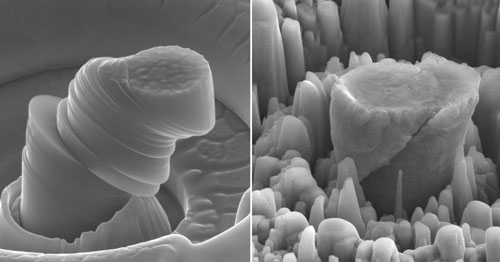On Christmas Eve the trade magazine NanoWerk reported:
"Researchers create exceptionally strong and lightweight new metal
"A team led by researchers from the UCLA Henry Samueli School of Engineering and Applied Science has created a super-strong yet light structural metal with extremely high specific strength and modulus, or stiffness-to-weight ratio. The new metal is composed of magnesium infused with a dense and even dispersal of ceramic silicon carbide nanoparticles. It could be used to make lighter airplanes, spacecraft, and cars, helping to improve fuel efficiency, as well as in mobile electronics and biomedical devices."
You can read the whole article at:
http://www.nanowerk.com/nanotechnology-news/newsid=42203.php 
On the left the failure mode of pure metal, on the right the more advantageous failure mode of magnesium 'alloyed' with nanoparticles of silicon carbide.
A well known RBT joker suggested:
> By next Christmas everyone will have donated their CF bicycles to the
> poor, and will be buying replacements made of this new alloy.
Yup, it's going to take over like that foamed aluminium with which Biomega built an ess-shaped bike frame about ten, twelve years ago.
Seriously, though:
I used to know Frank Costin, the -cos in Marcos, the aerodynamicist of the early Lotus cars. He made a really good case for wood being the ideal material for car chasses, and the proof was in the pudding, the Marcos raced at Le Mans still casually parked in front of English pubs for years to come... I built a moulded wood 68ft racing yacht that survived a whole lotta hard journeys (back and forth across the Southern Ocean in midwinter, around Cape Horn, cruising the Indian Ocean out of Mombasa for several monsoon seasons, a superior four-seasons passage maker once its racing days were over). Wood is indeed a wonderful engineering material. But wood never took off for loadbearing car structures and except as a luxury item for millionaire racers, it is a dead issue even in yachts.
As an aside rather than any kind of a big unit-number argument: Oddly enough, though the beautiful Renovo and other wood bikes are luxury items for rich eccentrics, wood may have a future in bicycles in the form of lashed-up bamboo bikes serving as cheap transport for the third world poor, vide Craig Coffee.
That's not all. I can remember how slowly GRP (glass reinforced plastic, FRP to Americans) took off back in the days before carbon fibre, and how every little scare quite disproportionately set back the small gains its enthusiasts made.
The question also arises whether the new material will have the ride qualities of steel -- or aluminum. If it has steel-like handling, and if various bonding issues that often plague new materials do not arise, and if the material is not too expensive, and if it doesn't require special in-service handling or coatings to remain stable, in a few years we might have an alternative to steel for bicycles.
From past experience with new wonder-materials I can't advise anyone to hold their breath.
To forget is to repeat the mistakes of the past.